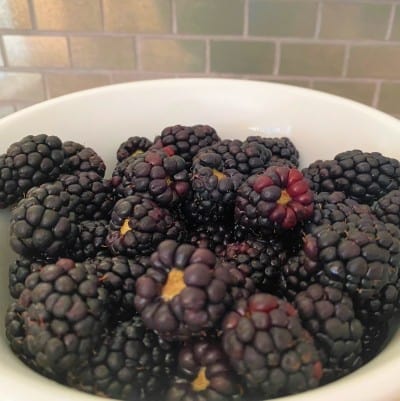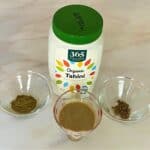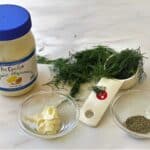Plain Greek yogurt is one of the best sauce-making weapons you can keep in your fridge. Thick and tarty, plain Greek yogurt becomes a piquant topping for lean, grilled proteins when combined with garlic, lemon zest, olive oil, and spices.

Would you like to save this recipe or article?
You won't get spam from me, I promise!
The Basic Savory Greek yogurt Sauce recipe below is a theme with variations. I've given you a couple of riffs. The first one with tahini veers toward the Middle East, and the second fish-friendly version gets a burst of flavor from fresh dill.
I encourage you to improvise on the basic yogurty theme. Love Italian cuisine? Stir in some pesto. Like it hot and spicy? Add chopped jalapeno or other chilies.
Or maybe you like the cool flavor of a raita or tzatziki, the Indian and Greek yogurt sauces that feature cucumber and (sometimes) mint? Here's a link to an article on the Masterclass website with an excellent raita recipe. 🌿
(The article explains that tzatziki is more of a sauce and raita is a side dish served to offset curries and other hearty Indian dishes.)
Creating healthy dips for guilt-free snacking is another hack to try with plain Greek yogurt. Blend a packet of ranch mix or some salsa into a cup or two of unflavored yogurt. Serve whole-grain chips, pretzels, or cut vegetables alongside for dipping.
Choose whole milk or low-fat plain Greek yogurt for the best tasting sauce or dip.
Credit: Micheile Henderson on Unsplash
Why is plain Greek yogurt healthy?
Plain Greek yogurt contains three nutrients that give it a nutritional shine and boost your health.
- Protein
- Calcium
- Probiotics
The skinny on protein in Greek yogurt
Plain whole-milk Greek yogurt has more than twice as much protein as plain regular whole milk yogurt. Although the two types of yogurt can be similar in terms of calcium content, regular yogurt usually contains more calcium and probiotics than Greek yogurt.
Because Greek yogurt is so high in protein, it's very sustaining. This has earned it a reputation as a weight-loss food. The higher amount of fat in whole milk Greek yogurt also helps stave off hunger.
| 1 cup | Greek yogurt, plain, whole milk | Regular yogurt, plain, whole milk |
|---|---|---|
| calories | 222 kcal | 140 kcal |
| protein | 21 grams | 8 grams |
| fat | 11.5 grams | 7 grams |
| carbs | 9 grams | 11 grams |
| calcium | 229 mg | 277 mg |

Nutrition labels: Fage 2% Greek and Wallaby regular whole milk. Both styles of yogurt are plain.
Calcium confusion?
Some sources, like the National Institutes of Health (NIH), put the amount of calcium in a cup of regular yogurt at 400 mg, more than the amount in the USDA database. By brand, the amount of calcium (and protein) in a cup of any type of yogurt is variable although regular yogurt has the calcium edge when compared to the thick, strained Greek style.
For example:
- Fage 2% plain Greek yogurt: 267 mg of calcium, 23 g protein per cup
- Wallaby plain whole milk yogurt: 377 mg of calcium,11 grams of protein per cup
(The serving size listed on the yogurt nutrition labels is ¾ cup, which is considered a breakfast or a snack portion.)
Even a small amount of any yogurt can help you reach the Recommended Dietary Allowance (RDA) for calcium, which 1,000 mg/day for most adults. Currently, many doctors prefer that you get at least 600 mg of this amount from real food rather than supplements.
One reason is that calcium is not well absorbed when taken in amounts greater than 500 mg. Small amounts ingested throughout the day are easier for a body to utilize.
Calcium is important for strong bones, of course, but it also supports muscle and nerve function and your heart's regular beating.
Can probiotics help with lactose intolerance?
The probiotics in regular and Greek yogurt, primarily Lactobacillus strains, are beneficial for gut health and nourish a healthy microbiome. Many people, even those who are lactose intolerant, find that they can digest yogurt, even though they experience discomfort with other dairy products.

Lactose is the milk sugar that causes bloating and digestive distress in more than 60% of the world's population. Our ability to break down this sugar decreases after infancy. This is particularly true if you are Asian; 70% to 100% of East Asian persons are lactose intolerant.
As milk ferments, it develops nutritious probiotic bacteria that give yogurt its characteristic tanginess. Fruit flavors of yogurt often have large amounts of sugar added to cancel out this sour flavor.
Is whole milk yogurt healthier than non-fat?
Whole milk Greek yogurt has a creaminess that tempers this acidic edge. Although whole milk yogurts have more saturated fat, questions exist as to whether whole milk dairy is worse for your health than non-fat.
The results of a recent epidemiological study with thousands of subjects suggest that some fat may better than none. Subjects who consumed two or more servings of full- or low-fat dairy had better health outcomes than the subjects who consumed non-fat dairy products.
(For more information on the PURE (Prospective Urban Rural Epidemiology) study, read my blog post, Dairy Do!)
Uber-healthy, ultra-tasty: Easy yogurt dips
Pair a Greek yogurt-based dip with cut veggies, whole-wheat pita chips, or tortilla chips. Here you have a satisfying snack that offers protein and fiber -- great for your gut and for your cravings.
A 2-tablespoon serving of a Greek yogurt dip supplies approximately 2.5 grams of protein, about the same as you'd find in an equal serving of hummus.

Credit: Polina Tankilevitch on Pexels
Combine a packet of ranch mix (like Hidden Valley) with 2 cups of plain Greek yogurt and blend thoroughly. Kids love this dip with carrot and celery sticks, strips of red pepper, and cucumber rounds. It's also great with (baked) chicken tenders!
Combine 1 cup of your favorite salsa, 1 cup of plain Greek yogurt, and 1 tablespoon of taco seasoning. Garnish with fresh cilantro and enjoy with tortilla chips and jicama sticks.
Stuffed Bakers: Use these dips to add nutrition and protein to a baked potato. Split a baked potato down the middle. Fluff the inside of the potato with a fork (and knife, if necessary) and spoon about a ¼ cup of yogurt dip into the potato. Sprinkle with 2 tablespoons of grated Cheddar-jack cheese, Melt the cheese using a toaster oven, the microwave, or the oven broiler.
Add a green salad to turn a stuffed potato into a meal!

Basic Savory Greek Yogurt Sauce
Equipment
- Medium bowl, reamer or citrus squeezer, zesting tool, garlic press, knife, measuring spoons, cutting board
Ingredients
- 1 cup plain Greek yogurt whole milk or 2% for best taste
- 2 Tablespoons lemon juice
- 2 Tablespoons Italian parsley, chopped
- 3 cloves garlic pressed
- 1 Tablespoon olive oil extra virgin, good quality
- 1 teaspoon grated lemon zest
- ½ teaspoon kosher salt
- ½ teaspoon freshly ground black pepper
Instructions
- Wash hands following CDC Guidelines.
- Place all ingredients in a medium bowl.
- Blend ingredients thoroughly and completely using a whisk or wooden spoon.
- Cover. Let the sauce stand at room temperature for 30 minutes if you plan on using the sauce right away. Otherwise, refrigerate for up to 5 days.Serve sauce with simply prepared proteins. It can also be used as a marinade with chicken and lamb, a dip, or a dressing for salads. Tip: The flavor of the garlic gets stronger as the sauce sits. Cut the garlic back to a single, large clove if you plan to store the sauce for longer than a day.Note: You may have to pour off or stir in any accumulated liquid (whey) when you pull it out of the fridge.
Video
Notes
- 3 Tablespoons of tahini, i.e., sesame seed paste
- Scant teaspoon of ground cumin
- ¼ teaspoon coriander
- 2 Tablespoons chopped dill (or 1 Tablespoon of dried)
- 1 teaspoon dried oregano
- 1 Tablespoon of mayonnaise
Nutrition
Copyright © 2021 Jani H. Leuschel









Jani H. Leuschel
Easy and delicious!
Jani H. Leuschel
I have not thoroughly investigated the yogurts made from plant-based milks. Sometimes, I will buy oat milk yogurts for my daughter, who avoids eating large amounts of dairy. (She does not drink cow's milk, but will eat yogurt made from cow's milk.) Plant milk yogurts are a great option for vegans or anyone with a true dairy allergy, not an intolerance. They are almost always fortified with calcium, vitamin D, and can contain other nutrients, as well. Often, they have a long ingredient list that includes additives like gums to make them thick.
Because the plant-based yogurts start with different sources, i.e. cashews and almonds, soybeans, oats, hemp, etc, their nutrition profiles vary tremendously. What's required is label reading. For instance, one brand of almond milk yogurt contains no vitamin D, is not a good source of protein, and contains added sugars in the plain variety.
You can almost always do better by making your own yogurt -- as you do! No extra sugar, probiotics for your gut, and a rich source of calcium, vitamin D, and other vitamins and minerals. You can also save a few $$$ and end up with a superior tasting yogurt!
Read the upcoming blog for some simple, low-sugar flavoring ideas for yogurt. I'm also giving an Instant Pot recipe for plain yogurt, but you won't need that if you're already using a yogurt maker!
Thanks for reading! ☺
Bill Young
Jani, I enjoy using my yogurt maker - simple and quick way to avoid the sugars that are often added to commercial yogurt. Lately I've been reading about health benefits of non-dairy yogurts, but they haven't convinced me - am with you about the taste and texture of Greek yogurt, and the vitamins I get from milk. Thoughts?
Jani H. Leuschel
Thanks, Mary. Hope you enjoy it! I know you're a yogurt fan. 😊
Mary Sallman
Very interesting blog. Can’t wait to try the recipe!